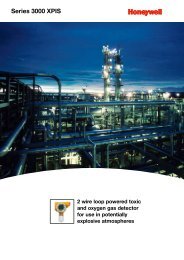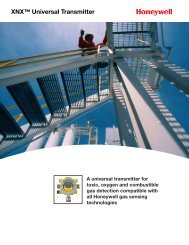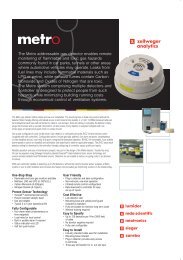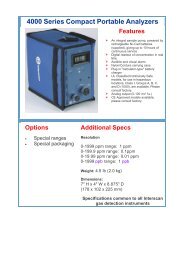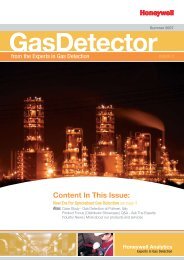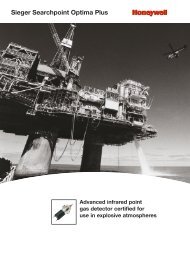The Hydrological Cycle - Monitoring Locations and ... - Apc.co.nz
The Hydrological Cycle - Monitoring Locations and ... - Apc.co.nz
The Hydrological Cycle - Monitoring Locations and ... - Apc.co.nz
Create successful ePaper yourself
Turn your PDF publications into a flip-book with our unique Google optimized e-Paper software.
<strong>The</strong> <strong>Hydrological</strong> <strong>Cycle</strong> - <strong>Monitoring</strong> <strong>Locations</strong> <strong>and</strong> Equipment<br />
Hydrolab<br />
Multiprobe<br />
Ott Level Senso<br />
Ott<br />
Datalogger<br />
Portable Data Collection<br />
(Vota & PDA)<br />
Ott Rain Gauge<br />
Ott Flow Sensor<br />
Hydromet Softw<br />
Ott<br />
Communication<br />
Ott Ground Station<br />
Buyout Items<br />
Rain<br />
Rivers<br />
Sampling<br />
Lakes<br />
Estuaries <strong>and</strong><br />
Shallow<br />
Ocean<br />
Ground<br />
Water<br />
Hydrolab <strong>and</strong> Ott Jointly Provide Full <strong>Hydrological</strong><br />
<strong>Monitoring</strong> Solution<br />
Presented By D J Catt
Key Innovations<br />
• 1965 - First in-situ water quality multiprobe<br />
• 1966 - First submersible pH sensor<br />
• 1967 - First 4-electrode <strong>co</strong>nductivity sensor<br />
• 1982 - First submersible multiprobe logger<br />
• 1992 - First 2 year instrument warranty<br />
• 1992 - First 1.75 inch (4.4 cm) multiprobe for<br />
groundwater monitoring (H20-G)<br />
• 1993 - First in-situ turbidity sensor<br />
• 1996 - First to integrate GPS <strong>and</strong> barometric<br />
pressure sensors (Surveyor 4a)<br />
• 1997 - First in-situ chlorophyll <strong>and</strong> ambient<br />
light sensors mounted on multiprobe<br />
• 1999 - First 3 year instrument warranty<br />
• 2001 - First 4-beam ratiometric, in-situ turbidity<br />
sensor<br />
• 2003 - First 0-3000 NTU Self-Cleaning Turbidity<br />
Sensor<br />
• 2004 - First multiprobe with blue-green algae<br />
fluorometer option.<br />
• 2005 – Series 5 Multiprobes installed with Hach<br />
LDO
Product Applications<br />
‣ Regulatory<br />
‣ Hydro Power<br />
‣ Fisheries Management<br />
‣ Groundwater<br />
‣ Non Point Source<br />
‣ Research/Educational<br />
‣ Near Coastal<br />
‣ Drinking Water Reservoir<br />
‣ Waste Water<br />
‣ Aquaculture<br />
‣ On-Line Real Time<br />
<strong>Monitoring</strong>
Hach LDO TM Available only on Series 5<br />
sondes<br />
• Reduced Maintenance<br />
– No membrane to replace<br />
• No more stretching of<br />
Teflon membrane with<br />
worries about air<br />
bubbles, wrinkles or<br />
membrane thickness<br />
– No electrolyte to foul or<br />
poison<br />
•No H 2<br />
S poisoning of the<br />
electrolyte<br />
• No more punctured<br />
membranes<br />
• No anode or cathode to<br />
refurbish<br />
– No circulator needed<br />
– 2-year sensor warranty<br />
– 1-year cap warranty<br />
LDO is the biggest breakthrough for multi-parameter sondes<br />
in 5 years!
How Does HachLDO Work?<br />
• A sensor cap is <strong>co</strong>ated<br />
with a luminescent<br />
material<br />
Probe<br />
• Blue light from an LED<br />
strikes the luminescent<br />
chemical on the sensor<br />
cap<br />
LED<br />
Photo Diode<br />
LED<br />
Sensor<br />
Cap<br />
• <strong>The</strong> luminescent chemical<br />
instantly be<strong>co</strong>mes excited
How Does HachLDO Work?<br />
• As the excited<br />
chemical relaxes, it<br />
releases red light<br />
• <strong>The</strong> red light is<br />
detected by a photo<br />
diode<br />
• <strong>The</strong> time it takes for<br />
the chemical to<br />
return to a relaxed<br />
state is measured<br />
LED<br />
Photo Diode<br />
LED<br />
Probe<br />
Sensor<br />
Cap
DS5x MULTIPROBE<br />
HACH LDO SENSOR<br />
SELF CLEANING<br />
TURBIDITY<br />
CONDUCTIVITY<br />
TEMPERATURE<br />
TOTAL<br />
DISSOLVED<br />
GAS
‣ A “nephlometer” emits a light from<br />
an LED at 880nm <strong>and</strong> a photodiode<br />
<strong>co</strong>llects the backscatter (right<br />
angle) from particles in the water;<br />
no particles, no backscatter<br />
‣ St<strong>and</strong>ard sensor is early generation<br />
nephlometer<br />
‣ <strong>The</strong> Self-Cleaning sensor has a pad<br />
which cleans the lenses on each<br />
measurement. Sensor is sunlight<br />
resistant <strong>and</strong> has an averaging<br />
feature.<br />
‣ 4-Beam is new revolutionary<br />
sensor that uses st<strong>and</strong>ard<br />
backscatter, yet has multiple<br />
beams/references checking <strong>and</strong><br />
rechecking its accuracy.<br />
‣ Ranges: Up to 3000 NTU’s on<br />
Self Cleaning sensor. 1000 NTU<br />
Turbidity<br />
4-Beam / Self-Cleaning / St<strong>and</strong>ard<br />
4-beam Self-Cleaning St<strong>and</strong>ard
Chlorophyll a / Blue-Green Algae / Rhodamine WT<br />
‣Based on Turner Designs<br />
Cyclops –7 Fluorometer<br />
‣Specifically redesigned to<br />
fit in Hydrolab multiprobes<br />
‣<strong>The</strong> three different<br />
parameters use the same<br />
basic fluorometer, but the<br />
light source <strong>and</strong> filters are<br />
specific to each.<br />
‣Customer can use a Solid<br />
St<strong>and</strong>ard, which checks to<br />
determine if the fluorometer<br />
is still within calibration.
Principle of Fluorescence<br />
Digital Readout<br />
Light Detector<br />
Wavelengths specific to <strong>co</strong>mpound<br />
Wavelengths created by<br />
<strong>co</strong>mpound, plus stray light<br />
Emission Filter<br />
Lamp<br />
Cuvette or<br />
Sample Cell<br />
Excitation Filter<br />
Many wavelengths of light<br />
Specific wavelengths of light
Advantages of Fluorescence<br />
Specific<br />
– No two molecules excite <strong>and</strong> emit at the same<br />
wavelength<br />
Simple<br />
– No treatment required for many applications<br />
Sensitive<br />
− Detect 0.02ug/L chlorophyll a<br />
Fast<br />
– Readings taken on-site
In vivo chlorophyll applications<br />
HABs<br />
Limnology<br />
Education<br />
Remote<br />
Sensing<br />
in vivo chlorophyll<br />
Water<br />
Treatment<br />
Fisheries<br />
Aquaculture<br />
Marine<br />
Research<br />
Extracted chlorophyll<br />
(a, b, c, pheo a)
Photosythetically Active Radiation Sensor<br />
(PAR)<br />
‣Measurement of light intensity at<br />
certain points in the water <strong>co</strong>lumn<br />
‣PAR intensity influences biota that<br />
rely on photosynthesis for nutrition<br />
‣Can be ordered as a single sensor or<br />
a Dual-PAR sensor for use to measure<br />
light both at the surface <strong>and</strong> down in<br />
the water <strong>co</strong>lumn.<br />
‣Two types of sensors – Spherical<br />
(Shown) <strong>and</strong> a flat-faced version for<br />
measurements directly above the<br />
multiprobe, where sunlight extinction<br />
is important.
Typical Installations<br />
USGS Stream<br />
Gauging<br />
Station<br />
• Datalogger<br />
• Tele<strong>co</strong>m<br />
• Sampler<br />
• Flow meter<br />
• Multiprobe<br />
Met Station<br />
• Datalogger<br />
• Tele<strong>co</strong>m<br />
• Rain Gaug<br />
• Radiation<br />
• Flow mete<br />
• Multiprobe
Nagasaki Bay, telemetry site
USGS San Francis<strong>co</strong> Bay
Taiwan Sun Moon Reservoir
Louisville Metro Sewer District “Long<br />
Term <strong>Monitoring</strong> Network”<br />
• 28 sites are long term<br />
monitoring sites<br />
• 20 special project sites<br />
• 2 week interval for data<br />
retrieval <strong>and</strong> general<br />
maintenance<br />
• 15 minute intervals <strong>and</strong> solar<br />
powered<br />
• Partnering with USGS for<br />
discharge only on long term<br />
sites<br />
• Macroinvertabrate <strong>and</strong> algal<br />
surveys are performed on all<br />
long term sites
N.C. State University Site<br />
Madsen River Site
DS4x Post deployment<br />
Madsen River Site
What is Blue-Green Algae?<br />
• Scientific description is<br />
“Cyanobacteria”<br />
• Photosynthetic bacteria<br />
present in most freshwater<br />
<strong>and</strong> marine systems<br />
• Be<strong>co</strong>mes visible when<br />
bacteria <strong>co</strong>ncentrates <strong>and</strong><br />
‘algal blooms’ float to the<br />
surface<br />
• Heavy toxic <strong>co</strong>ncentrations,<br />
or Harmful Algal Blooms<br />
(HAB’s), can cause health<br />
risks to humans <strong>and</strong> animals
Drinking Water Facility Issues<br />
• United States Environmental<br />
Protection Agency placed<br />
Cyanobacteria on its Drinking Water<br />
Contaminant C<strong>and</strong>idate List<br />
• Currently listed as an Unregulated<br />
Contaminant<br />
• HAB’s in drinking water facilities can<br />
cause:<br />
– Public health risks<br />
– Foul taste <strong>and</strong> smell<br />
– Clogged filters<br />
– Unsafe <strong>co</strong>nditions for recreational<br />
use<br />
– Potential death of stock <strong>and</strong> wildlife<br />
– Foul smell <strong>and</strong> unpleasant<br />
appearance<br />
– Fish kills
Blue-Green Algae Sensor by Turner Designs<br />
Available as an option on the Hydrolab DataSonde 4a or<br />
DataSonde 4X<br />
• Note: Detecting Blue-Green Algae requires special optics for<br />
marine water… both marine <strong>and</strong> freshwater option is available<br />
today<br />
Optical Characteristics<br />
• Light Source: Light<br />
Emitting Diode<br />
• Detector: Photodiode<br />
• Excitation Wavelength:<br />
590nm<br />
• Emission Wavelength:<br />
650nm
<strong>Monitoring</strong> should include:<br />
• 1. Field observations for planktonic algae blooms, attached algae biomass,<br />
filter head loss, etc.<br />
• 2. Taste <strong>and</strong> odor monitoring at the treatment plant <strong>and</strong> distribution<br />
system by simple T&O tests, FPA tests (flavor profile analyses), TON tests<br />
(threshold odor number), also using the more expensive GC analyses for<br />
odor <strong>co</strong>mpounds such as geosmin <strong>and</strong> other parameters.<br />
• 3. Routine algae sampling with micros<strong>co</strong>pic analysis for cell <strong>co</strong>unts <strong>and</strong><br />
species identification.
Intense Summer Stratification at a Water Intake
End of Hydrolab/OTT Water<br />
Quality <strong>Monitoring</strong><br />
Presentation<br />
Questions?



